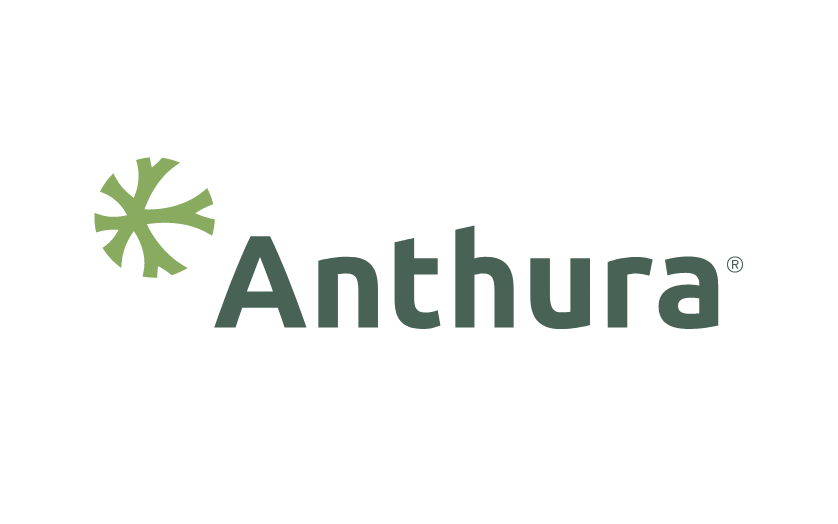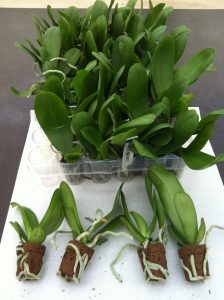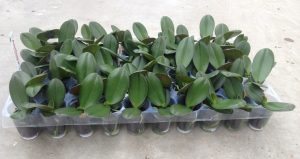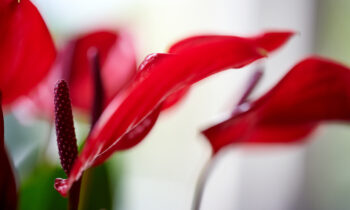Anthura, as well as other important plant suppliers, have been delivering plants grown in plug trays for a while now. Since last year, these amounts have increased substantially and it is expected that in the near future all young Phalaenopsis plants will be grown in plug trays.
Uniformity
Plants grown in plug trays are generally more uniform than plants delivered in a pricking-out tray. This is due to the fact that the plugs get water more evenly and thus dry out less rapidly. Furthermore, the plants in the tray are better distributed compared to a pricking-out tray, which ensures that each plant has its own separate space. Consequently, the percentage of ‘small plants’ delivered is also lower.
Hygiene
In addition, this is a step forward in terms of hygiene. When plants are isolated, there is less chance of a sick plant affecting the healthy ones. This applies more specifically to soil fungi. As a result, the disease pressure will further decrease and the delivered plant material will be even healthier.
Faster growth after repotting
When plants are potted in plugs, only limited root damage occurs. By way of comparison: when young Phalaenopsis plants are repotted from a pricking-out tray, about 60% of the roots are damaged! This makes a big difference in the growth speed during the first stage after repotting. A second important advantage at this stage is the moisture in the plug. Bark substrate is by nature quite dry. As a result, the plant misses the necessary microclimate in the first weeks after repotting. Because the plug stays slightly moister, the microclimate around the plant is better. This helps aboveground growth to start faster.
Cultivation method
The cultivation of a plant in a plug tray is in several ways different from that of a plant in a pricking-out tray. The differences are most apparent at the beginning of cultivation, because the influence of the moister plug is relatively stronger. When the plants are larger and start to evaporate more, the impact of the plug will become much lower.
Irrigation
It is important to irrigate in the first weeks of cultivation for the plants to take root. This applies particularly to the cultivation of Phalaenopsis in plugs. It is advisable to irrigate the plants quite frequently in the first few weeks of the cultivation but with little water. This will force the roots to start looking for water actively, which will benefit root growth and activity. Our advice is as follows:
| Irrigation frequency | Irrigation volume | EC | Intermediate session | |
| Start; week 0-3 | 1x per 2 days | 3-4 l/m² | 0.3-0.5 mS/cm | No |
| From week 4 | 1x per 4-6 days (as required) |
12-14 l/m² | 0.8-1.0 mS/cm | Yes, ±1½ l/m², EC= 0.0 mS/cm |
In later stages, the cultivation is similar to that of plants from a pricking-out tray. On balance, you will need to water less frequently, which makes it hard to operate the two systems with a single irrigation scheme. The top surface of the substrate in a plug generally dries less quickly, which reduces the need for an intermediate session. Yet it is advisable to give an intermediate session of 1 to 2 l/m² without nutrients if the top layer of the substrate is dry while the rest of the substrate is not yet in need of an irrigation session.
Connection of the substrate
Connection means the contact between the plug and the rest of the substrate in the pot. When the water management in the pot is good, water transport takes place between the plug and the substrate. This water transport is called ‘capillarity’. This is not possible when the substrate is too airy or too coarse. For this reason, we advise against growing plants cultivated in a plug tray in a bark mixture of sphagnum with 100% fraction 2. When there is too little contact between the substrate and the plug, the plug will stay wet longer and the substrate will dry out faster.
A substrate like bark has little or no capillarity (depending on the fraction), while coconut husk (chips) does. Many growers already mix coconut husk with the substrate. Especially when working with plugs, this has proved to be very advantageous in practice. These good results have been achieved with a mix of bark (60-70%) and coconut husk (30-40%). Apart from a mix of coconut husk and bark, there are also other possibilities: many tests are being carried out on the addition of lumps of peat to the substrate, which has similar properties.
In short, there is a great deal of movement in the use of substrate for the cultivation of Phalaenopsis. And now, with the arrival of plugs, there are a lot of possibilities to increase the cultivation of Phalaenopsis to an even higher level.
This article has been prepared with the cooperation of Bureau IMAC. Anthura and Bureau IMAC cannot be held responsible for any damages, whether direct or indirect, resulting from the use of the cultivation advice given.
Optional (depending on the article)
- The grower is at all times responsible for consulting the label of crop protection products.
- The cultivation information provided is geared towards Dutch growing locations.







